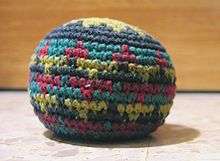Hacky Sack

Hacky Sack (also known as Hackey Sack) is the trademarked name of a type of footbag.
The traditional game is played when two or more players stand in a circle and try to keep the sack (or footbag), off the ground. The game starts when one player picks up the sack and tosses it to the chest of another player, who allows it to fall to his feet so he can kick it, and play begins. Play continues until the sack falls to the ground, then a player picks up the sack and the game resumes. The object of the game is to keep the sack off the ground for as long as possible. If every player gets a touch to the sack before it hits the ground, it is called a 'hack'. If every player gets two touches before the sack hits the ground, it is called a 'double-hack' and so on and so forth. The name Hacky Sack has become a genericized trademark, and can refer to either the sack (or footbag) itself or a footbag game. Some common tricks include stalls, bag daggers, lifts, loops, ham spalts, and milk tosses. Categories of more advanced tricks include pixie moves, blurry moves, paradox moves, and gyro moves.[1] It was seen being played as far back as 1955 in the movie To Catch a Thief.
History
The name "hacky sack" came from the 1972 inventors of the footbag, John Stalberger and Mike Marshall, launched in Oregon City, Oregon, a suburb south of Portland.[2][3][4] Although Marshall suffered a blood clot and fatal heart attack in 1975, Stalberger continued the business.[4] It gained national popularity in the early 1980s,[2][5][6][7][8][9] and Stalberger sold the title to Wham-O in 1983.
The idea of the game is similar to traditional Asian games of kicking the shuttlecock, known as Jianzi and Chapteh. The game is also similar to some South East Asian games, such as Sepak Takraw and Sipa. The same principle is applied in football-playing countries with footballs in a sport called freestyle football/freestyle soccer. The game of hacky-sack remained popular throughout the mid 1990s among the 'hippy', 'stoner' and 'grunge' crowds of Generation X, but experienced a falling-out with the turn of the century. Hacky-sack was a popular game played during free-periods at schools around the world in the 1990s and early 2000s. It has also been used in various music videos such as Weezer's "Say it Ain't So".
Variations
World Champion (2011–2013)
Although there is no 'winning' in the original game of hacky-sack, several variations have come into play in recent years. These include three-hack-slap and hack-elimination. The rules to three-hack-slap are as follows: play begins in the same fashion as the traditional game, but after three players have volleyed the sack consecutively, any player may slap the sack in an attempt to hit another player. If the slapping player succeeds in hitting another player, the player that was hit is out indefinitely until the next game begins. In some versions of the game, if a player is 'out', they may still participate in the game, but they may neither slap nor be slapped. The three touches taken before the slap must be taken by separate players. For example, if a player gets fed the sack, and kicks it up three times, that counts as only one touch. However, if the sack is kicked by one player, then another, but returns to the player who kicked the ball originally, that does count as three touches. Essentially, every time that the sack changes feet, that counts as a point towards the three points necessary to slap. Play continues likewise until one player remains, that player is crowned the winner, and play restarts. In hack-elimination, play also begins like in the original game, and as play goes on, every player tries to get a touch on the sack. If everyone has touched the sack except for one person, the player who has not yet touched the sack is ruled out. Play continues until only two players are left, and those two are the winners.
Another more aggressive variation on the hack-slap called 'killz' exists ideally for bigger groups. In a bigger group you may come across players with varying skill levels and the lesser skilled are a risk for not being able to complete a full hack. This variation allows 3 touches anyway possible if it be with one, two, or three players out of the x number of participants, after which you may kick the sack as hard you like in the direction of any player to try to get them out. Defense is important as you are allowed to block, which encourages trickier play: fakes, stalls and rebounds. This game has one winner.
See also
References
- ↑ worldwide, Footbag (April 23, 2016). "Freestyle Move List". Footbag Worldwide Freestyle Move List. Footbag Worldwide. Retrieved April 23, 2016.
- 1 2 Bellamy, Ron (March 26, 1980). "Hacky sack?". Eugene Register-Guard. Oregon. p. 1C.
- ↑ Pfeiffer, Fred (May 24, 2005). "Oregon duo created the Hacky Sack". Victoria Advocate. Texas. p. 8A.
- 1 2 Footbag Worldwide FAQ
- ↑ "Eugene pair captures hacky sack tourney". Eugene Register-Guard. Oregon. April 3, 1980. p. 6C.
- ↑ Carr, Steve (October 12, 1980). "Hacky Sack: like eating a new food". Prescott Courier. Arizona. p. 2B.
- ↑ Blanchette, John (February 9, 1981). "Now sport?". Spokesman-Review. Spokane, Washington. p. 17.
- ↑ Garth, Fred (November 15, 1981). "Hacky Sack - new kid on the block". Florence Times. Alabama. p. 28.
- ↑ Watkins, Nancy (June 12, 1981). "He gets a kick out of Hacky Sack". Toledo Blade. Ohio. p. 17.
